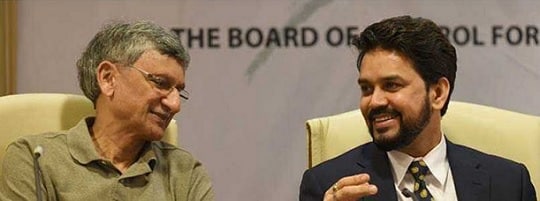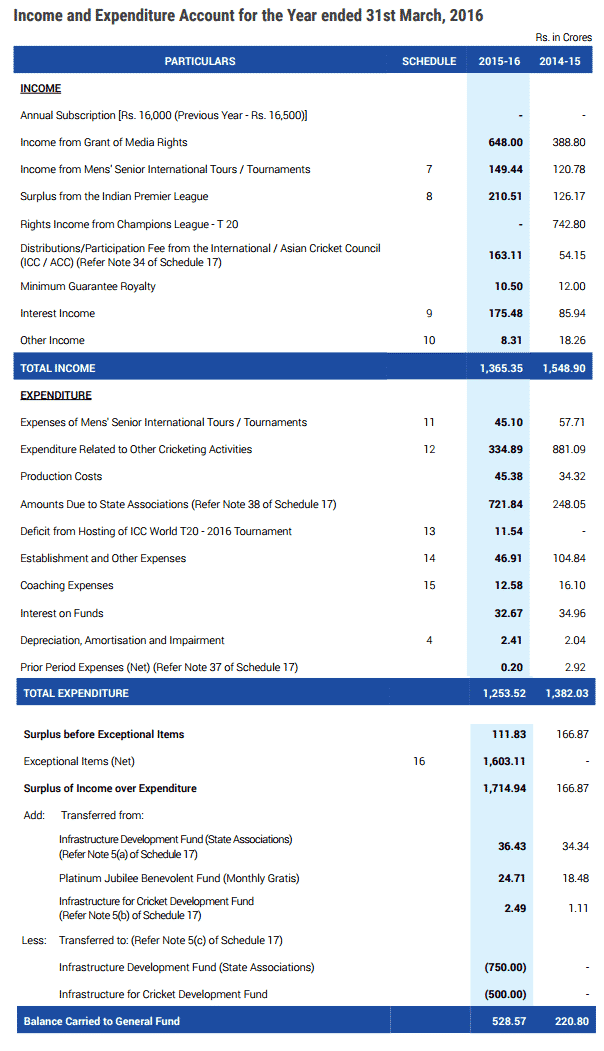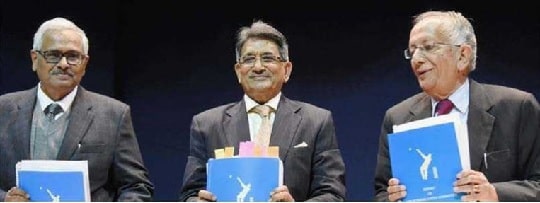“If the International Cricket Council (ICC) is the voice of cricket, the Board of Control for Cricket in India (BCCI) is the invoice of cricket.” said late Mansoor Ali Khan Pataudi in 2010. A senior BCCI official unabashedly said, “It wouldn’t be wrong to call us the big brothers of international cricket. We enjoy a similar clout in the ICC as the United States of America does in the United Nations.” This article looks at What is BCCI? Finances of BCCI, how it earns and spends? Why was Lodha Committee Formed? Recommendations of Lodha Committee?
Table of Contents
About BCCI
The Board of Control for Cricket in India (BCCI) is the national governing body for cricket in India. The board was established in December 1928 under the Tamil Nadu Societies Registration Act. It’s a consortium of state cricket associations and the state associations where they select their representatives who in turn elect the BCCI officials. Cricket in India at all levels is governed and managed by the Board of Control for Cricket in India, the wealthiest Board in the cricket world. The board backs the popular Indian Premier League (IPL), which sees various franchise teams across different Indian cities contesting every year under the Twenty20 format. Why BCCI was regsitered in Tamil Nadu and other details at What Is The Business/Organizational Structure Of BCCI And Why Is It Registered In Tamil Nadu?
Constitution of BCCI
The constitution of BCCI forms a Working Committee and various other Committees and Members. The BCCI’s constitution provides for annual elections at its Annual General Meeting (AGM) for all posts, with a bar on the re-election of an incumbent president beyond two consecutive years, “provided that the General Body may in its discretion re-elect the same person as president for the third consecutive year”. The main working of BCCI’s daily affairs is looked after by the Working Committee. The President is mainly questioned about its working, and he leads the Board officially. The Secretary helps in the operation of the bank accounts as a sole signatory and also his name is used when the Board sues or is sued by an outsider if disputes arise.
Anurag Singh Thakur was elected BCCI president on May 22, 2016, Ajay Shirke is Secretary, BCCI. Anurag Singh Thakur took over from Shashank Manohar who was President of BCCI from 4th October, 2015 to 10th May, 2016. Anurag Singh Thakur is also member of Lok Sabha from Hamirpur in Himachal Pradesh as a candidate of Bharatiya Janata Party He is the son of Prem Kumar Dhumal, the former Chief Minister of Himachal Pradesh. He is third time MP. Member of 14, 15 and 16th Loksabha. first elected to Lok Sabha in May 2008. Shashank Manohar was elected as the first Independent Chairman of the ICC for a two year term 2016-18. Shashank Manohar is the fourth Indian to occupy the prestigious position after Mr. Jagmohan Dalmiya, Mr. Sharad Pawar and Mr. N. Srinivasan.
India is cricket’s biggest provider. Some cricketing nations are virtually dependent on India for their revenues. A tour by the Indian cricket team is the most sought after among every cricketing nation, thanks to the television money it generates for the host board. The TV rights money generated by an India tour, virtually sustains that board, its affiliate bodies (states, counties or clubs). Besides, they also earn good profit through gate receipts, thanks to increased attendances from the Indian diaspora.
BCCI Finances
BCCI does not depend on the Government of India for its finances. Board of Control for Cricket in India,the richest cricket board in the world ,reported a whopping 928% jump in net profits to Rs1,714.94 crore for the year ended March, 31, 2016. BCCI earns money from Media Rights Income, Income from International Tours, Rights Income from Champions League T-20, Sponsorship Income, Distributions from ICC, Other Income, etc. It spends on Mens’ Senior International Tours / Tournaments, Women Tournaments, Carry out infrastructure development say renovation of stadium or establishing Cricketing facilities across the country, Organizing domestic tournaments like Ranji Trophy, pay for Players Salary at various levels. From BCCI Annual reports on BCCI webpage. (pg 148-149) the Income and Expenditure account of BCCI for year 2015-16 and comparison with year 2014-15 is given below.
The BCCI became the game’s richest sporting body under leadership of Jagmohan Dalmiya who began his innings at the BCCI in 1979, before taking office as its treasurer in 1983. In 1987, he helped bring the cricket World Cup to the subcontinent for the first time. During these years, he also crafted a series of lucrative television deals—and set the foundation for transforming the gentleman’s game into the money-spinning spectacle that it is today.
In 1993, Dalmiya won a legal battle against broadcaster Doordarshan for selling the television rights of cricket matches in India. The outcome of the legal battle was that Doordarshan had to pay the BCCI for acquiring the rights to televise Indian matches. In 1995, the rights were ruled by the Supreme Court of India as a commodity owned by BCCI and could be sold to the highest bidder. The ruling allowed BCCI generate more revenue and strengthened BCCI’s position in the global marketplace. And Then came IPL.
IPL
THE INDIAN PREMIER LEAGUE (IPL), which completed its ninth season in 2016, is the biggest brand ever in cricket history. In 2015, the valuation appraisal firm Duff & Phelps estimated the IPL brand to be worth $4.5 billion (Rs 27,000 Crores). According to the Broadcast Audience Research Council of India, total TV viewership of IPL 2016 calculated by impressions stood at 102 Crores. A report by management consultancy firm KPMG puts the total impact of IPL 2015 on the Indian economy at Rs 1,150 Crores, more than 0.6 per cent of the country’s GDP. IPL’s predominant source of income is its corporate sponsors. This is a guaranteed sum generated annually from the league’s official sponsors. A pre-determined percentage of funding (approximately 60%) received from sponsors sees an equitable distribution amongst all franchises. Similarly, television broadcasting rights of the games is another spectacular source of funding as a chunk of its proceeds as BCCI distributes it equally amongst franchises. The Board of Control for Cricket in India stated that the Indian Premier League has scripted faster growth than the football league Manchester United. Our article Is IPL the Indian Premier League the Indian Paisa League? discusses IPL in detail.
Lodha Committee
One of the world’s richest and most powerful sports bodies, the BCCI has been dogged by financial scandals and allegations of mismanagement for decades.
In the mid-2000s, a petition was filed by Zee Telefilms Limited after the board cancelled TV rights initially awarded to it. Zee had to first establish before the five-judge SC bench that the BCCI was a public body and then file a writ petition. But the board managed to assert that it was a private organisation, registered under the Tamil Nadu Societies Act and hence not answerable to a writ petition.
BCCI was dragged to the Supreme Court in the wake of the 2013 Indian Premier League (IPL) spot-fixing scandal.
- Then board president, N Srinivasan, faced a conflict of interest case over owning the Chennai Super Kings IPL team while being a senior office-bearer, after a key BCCI rule was tweaked to facilitate the purchase ahead of the inaugural edition in 2008.
- Aditya Verma, secretary of the unrecognised Cricket Association of Bihar, pushed for action against Srinivasan, demanding the Tamil Nadu industrialist step down after his son-in-law and CSK official, Gurunath Meiyappan, was arrested by the Mumbai Police for illegally betting on IPL matches.
- Srinivasan argued that Meiyappan was a mere enthusiast. But the Apex court asked him to ‘step aside’ till the case was decided.
- A controversial two-member BCCI panel gave a clean chit to Meiyappan and Rajasthan Royals co-owner Raj Kundra, but the decision was struck down by the Supreme Court.
- The SC ordered a probe into the IPL scandal by former high court judge, Mukul Mudgal. In January 2015 Supreme counrt appointed a three-member panel headed by former Chief Justice of India, RM Lodha, and retired judges Ashok Bhan and RV Raveendran to decide on the punishment for CSK and RR and the two officials involved as well as suggest reforms in the board to prevent such problems in future.
- On January 4, 2016, RM Lodha, the former Chief Justice of India, unveiled the three-man committee’s recommendations.
- The final order of the two-judge bench comprising TS Thakur, the Chief Justice of India, and Justice Ibrahim Kalifulla, signed off on most of the Lodha proposals, setting in motion a major revamp of the way cricket is run in India.
- The Lodha panel banned Meiyappan and Kundra from cricket for life and suspended CSK and RR, both former IPL champions, for two years, keeping them out of the 2016 and 2017 editions.
Recommendations of Lodha Committee
Lodha committed submitted 159-page report (pdf) to the Supreme Court, which will decide whether these recommendations would be binding on the BCCI, Lodha said he held 38 meetings with Board officials, cricketers and other stakeholders. The Lodha Committee has sought the ouster of the entire top brass of the BCCI and the court must appoint an interim board SC must take contempt against the erring BCCI officials, according to the Lodha Panel. The scathing report openly criticises the BCCI for stalling reforms and being in complete contempt of the Supreme Court order.
BCCI has taken some steps towards transparency when Shashank Manohar took charge in October 2015. From the board’s constitution to the tendering process, a lot is now on its website. Justice (retd) A P Shah has been appointed as an independent ombudsman who has the last word on questions related to conflict of interest. But the judiciary felt more needs to be done. The bench of Chief Justice T S Thakur and Justice F M I Kalifullah have found the Lodha committee recommendations “straight, rational and understandable” that “deserve respect”, and “there is no reason to disagree with the committee”. The BCCI has opposed the decisions, and still argues that it is a private body under the societies act, though the court has ruled that it carries out a public function.
On July 18 2016, the Supreme Court accepted the Lodha panel report and directed its time-bound implementation. Lodha panel set the BCCI two deadlines – September 30 to make constitutional changes and December 15 for the Board to form a nine-member Apex committee that will replace the working committee. But BCCI has raised many objections to it. BCCI has taken steps to usher in transparency and toning up the administration by appointing a CEO and putting out financial transactions on its website. But it opposes the root-and-branch changes as directed by the three-member Lodha committee. You can read full report here
- Volume cover 1
- Volume cover 2
- Volume final 1
- Final report – Volume 2
Overview of Recommendations by Lodha Committee
- Lodha panel wants BCCI to come under RTI Act
- Lodha panel recommends legalisation of betting The panel recommends players and BCCI officials should disclose their assets to the board in a measure to ensure they do not bet.
- Lodha panel proposes one state, one vote. Also no proxy voting of individuals This means, for example, the large state of Maharashtra with multiple associations in Maharashtra, Mumbai and Vidarbha each have their respective representative and vote during elections. If recommendation is implemented, the entire state will have just one vote.
- No BCCI office-bearer can have more than two consecutive terms. The Lodha panel recommends a maximum of three terms for office bearers with no more than two consecutive terms. It further says there should be a cooling period after each term.
- No BCCI office-bearer can be Minister or government servant.
- In no case President will hold post for more than 2 years
- Lodha panel recommends a steering committee headed by former Home Secy G K Pillai with Mohinder Amarnath, Diana Eduljee and Anil Kumble
- Panel recommends separate governing bodies for the IPL and BCCI
- Lodha Committee recommends relegation of Railways, Services and Universities as Associate members. They also lose voting rights.
Related Articles:
- Sports person income and endorsments : Virat Kohli, Maria Sharapova
- Cricketer and Money
- Is IPL the Indian Premier League the Indian Paisa League?
- Sports as career:So your child wants to be cricketer,badminton player
- What does Bharat Ratna winner get?
[poll id=”93″]
Given the passion cricket arouses in Indian hearts, trusteeship of the sport brings with it great responsibility. The BCCI is a strong body and has withstood evolution of over 87 years of existence. The Board of Control for Cricket in India (BCCI) and the Lodha committee are at loggerheads over the absolute implementation of the panel recommendation . As a cricket fan cricket matters(India winning especially) . Yes there should be transparency and accountability on the part of those who run or manage the game in the country. But the problem arises if in the name of transparency and accountability, the recommendations of the Lodha committee are too overweening – it would be an overreach and instead of reforming and clearing the game of evil influences, the game will get debilitated in the process. Can there be a middle path to resolve the issue? This will only become clear on October 17 when the apex court resumes hearing on the matter. What do you feel about Lodha committee and BCCI conflict?







This article sounds like a piece of BCCI and does not seem to realize the massive corruption in the sports body. Various sports bodies in India are facing various kinds of administrative and corruption issues and no political party wants to act upon it because almost all political parties have a role in them..
When someone wants to cleanup the system such kind of articles mislead by painting them in bad picture and siding with corrupt parties..
I am referring to the concluding piece of this article.. Are the measures taken by them good enough?? How are we sure that it will not return back if recommendations are not put in place? Does the author even have idea of the amount of corruption and misadministration and nepotism existing within BCCI and other sports bodies?
Of late I am seeing that this blog is trying to side with policies of one govt or in general with parties..